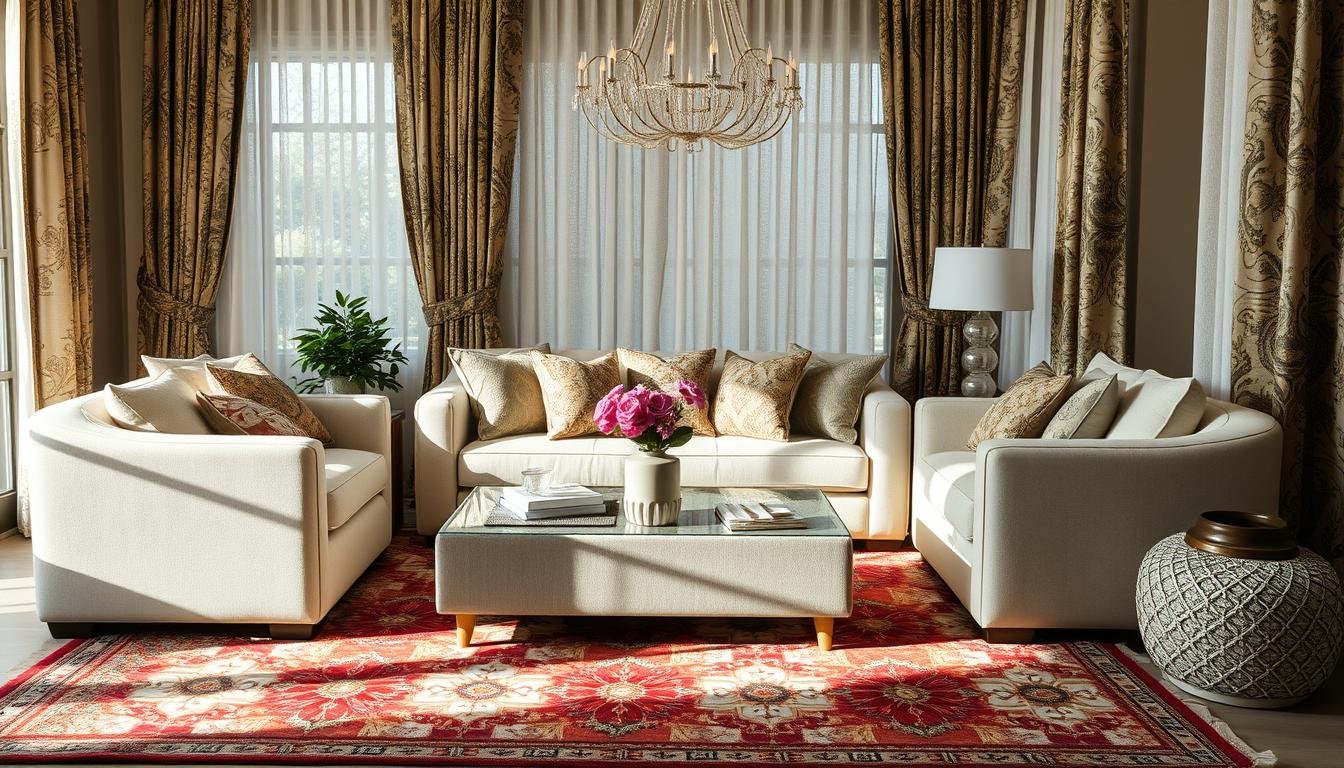Some links on this page are affiliate links. This means we may earn a commission at no additional cost to you if you click through and make a purchase. Thank you for your support!
Ready to make your living spaces pop with patterns mixing? Get ready to become your own interior designer. We’ll show you how to blend rugs, cushions, and drapes in a way that will wow everyone. You’ll learn about pattern types, scale, and color coordination.
By the end, your home will look like it’s straight from a design magazine. It’s time to unleash your creativity and make your space stand out.
Understanding Pattern Fundamentals
Patterns in home textiles add depth and interest. They can turn a room into a stylish oasis. Let’s explore the basics of pattern in home decor and how to mix them well.
Basic Pattern Types in Home Textiles
There are many pattern types in home textiles, each with its own charm. Some common ones include:
- Florals: These textile patterns bring a natural and feminine touch to a room.
- Stripes: Versatile and classic, stripes can add energy or coziness.
- Geometrics: Angular designs like chevrons and herringbone add a modern feel.
- Abstracts: These patterns offer a unique, artistic look in textiles.
ALSO READ: How to Use Stripes, Checks, and Florals in Your Home Decor
The Role of Scale in Pattern Selection
The size of a pattern is key to a cohesive design. Mixing patterns of different sizes adds depth and interest. Pair a large, bold pattern with a small, subtle one for balance.
Color Theory and Pattern Coordination
Color ties patterns together, and color theory is crucial. Use a consistent color palette and the color wheel to choose colors. Consider the saturation and undertones of colors for the best look. Try bold colors or a neutral palette for cohesion.
Learning about pattern, scale, and color will help you create a stunning interior. The goal is to balance patterns and colors for a harmonious look.
The Art of Pattern Scale Mixing
Pattern mixing is all about blending different designs to make a space pop. It’s about mixing large and small patterns in a smart way. This can turn a simple room into something amazing!
Start with a “hero” fabric to set the style. This fabric is the base, and you can add more patterns around it. Designers share many examples, like pink or blue and green, to help you get started.
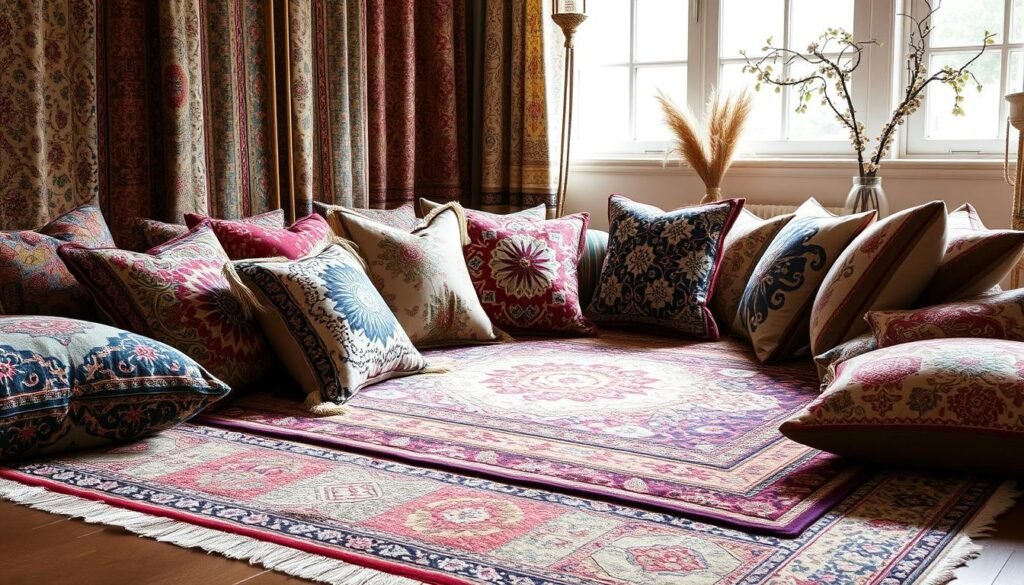
Choosing fabrics of different sizes is key. This mix adds depth and interest. A good trick is to pair one big pattern with several small ones for a balanced look.
Use neutral colors for walls and big pieces to let patterns shine. This way, your textiles can be the stars without feeling too much. Try mixing florals, stripes, and shapes to add depth and personality.
At first, pattern mixing might seem hard. But with practice, you’ll get the hang of it. Trust your instincts and let your space reflect your style!
Color Coordination Strategies for Mixed Patterns
Learning to mix colors is crucial for home decor with various patterns. By matching colors, we can blend different patterns smoothly. This creates a space that’s both beautiful and unified. Let’s look at how to achieve this balance.
Creating Color Harmony
Color harmony is the base of mixing patterns. Begin by picking a core color scheme. Use both main and secondary colors that go well together. This color scheme will hold your patterns together, making the room look cohesive.
Working with Neutrals
Neutral colors like beige, gray, and white are great for mixing patterns. They offer a solid base for bold patterns and colors. Start with neutral fabrics, then add patterned and colored accents for depth and interest.
Bold Color Combinations
For a bold look, mix patterns with contrasting colors. Try pairing bright colors like turquoise and fuschia or mustard yellow and indigo blue. Be careful not to overdo it to avoid overwhelming the space.
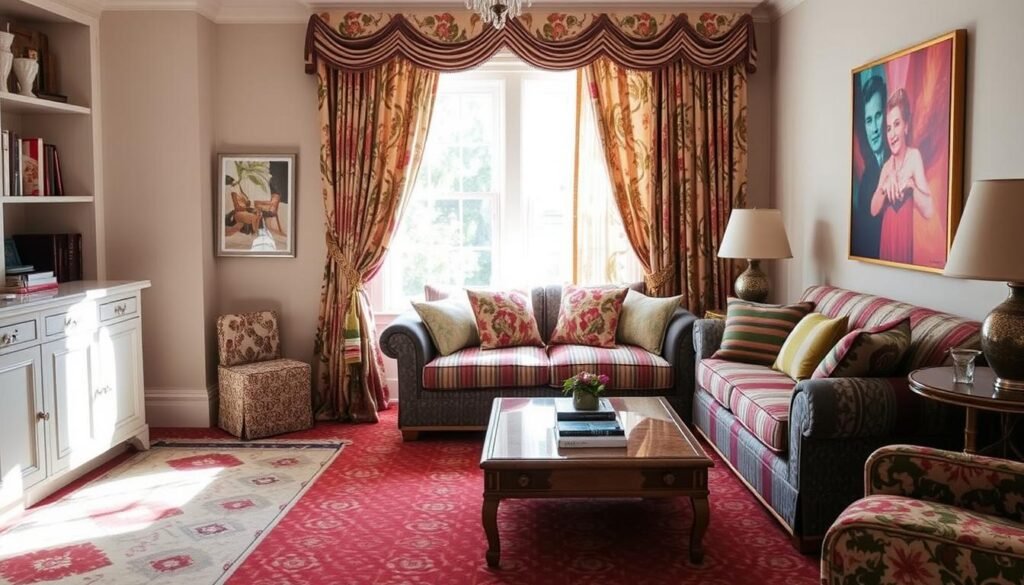
Success in mixing colors comes from finding the right balance. Try out different color combinations, sizes, and textures. This will help you find a style that suits you and makes your space stunning.
Essential Guidelines to Combine Patterns
Learning to mix patterns in home decor can make your spaces more stylish and personal. We’ll share key tips for combining patterns like a pro. Get ready to make your interiors visually stunning and full of joy!
The rule of three is a golden rule in pattern mixing. Using three different patterns in a room creates a balanced look. Choose patterns of different sizes – large, medium, and small. This mix prevents your space from feeling too busy or chaotic.
Another important tip is to balance pattern types. Mix geometric patterns with floral designs or bold prints with subtle textures. This makes your room visually appealing and cohesive.
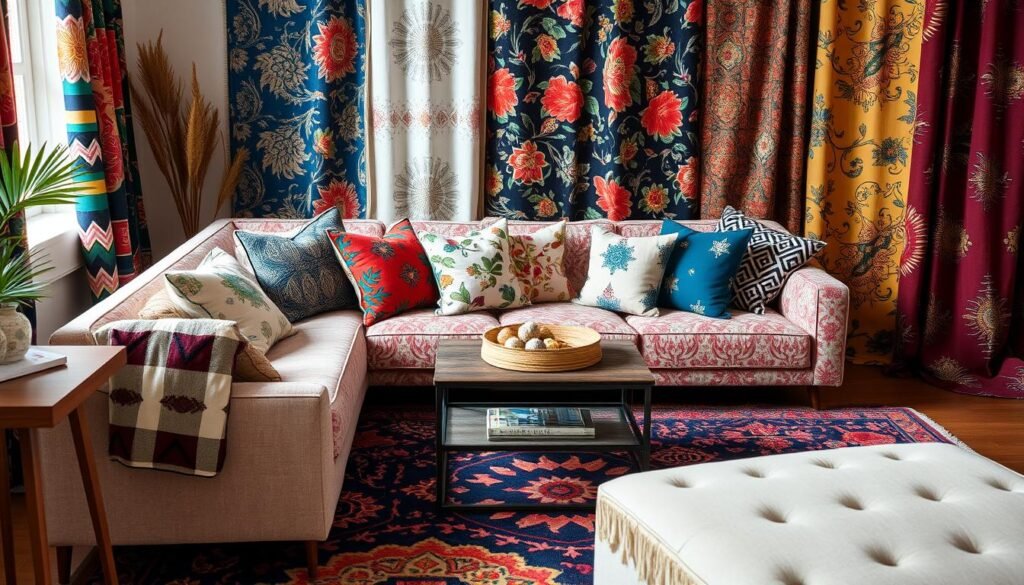
To avoid clutter, focus on the color palette. Pick a main color that connects your patterns. Then, add complementary or similar shades. This keeps the space harmonious, letting the patterns stand out.
The key to great pattern mixing is finding the right balance. Try out different mixes, watch the sizes, and listen to your gut. With these tips, you’ll create amazing, pattern-filled spaces that show off your style.
Traditional Pattern Mixing Techniques
Using old-school pattern mixing can make your home feel new again! You can mix classic floral and stripe patterns, or add damask and toile for a touch of elegance. There are many ways to blend these patterns for a look that’s both sophisticated and welcoming.
Classic Floral and Stripe Combinations
Florals and stripes are timeless because they work so well together. Pairing soft floral prints with sharp stripes creates a cozy yet elegant feel. The trick is to match the size and boldness of the patterns so they look good together.
Incorporating Damask Patterns
Damask patterns add a touch of timeless beauty to any room. Use them on wallpaper or upholstery, then balance with simpler patterns or solid colors. This mix of fancy and simple makes for a stunning and balanced look.
Working with Toile
Toile brings a traditional charm with its pastoral scenes. Pair toile with stripes or simple shapes to create a cohesive look. This way, you celebrate toile’s beauty without overwhelming the space.
Learning these traditional pattern mixing tricks can make your home feel classy and stylish. The secret is to balance size, color, and boldness for a look that’s both beautiful and harmonious.
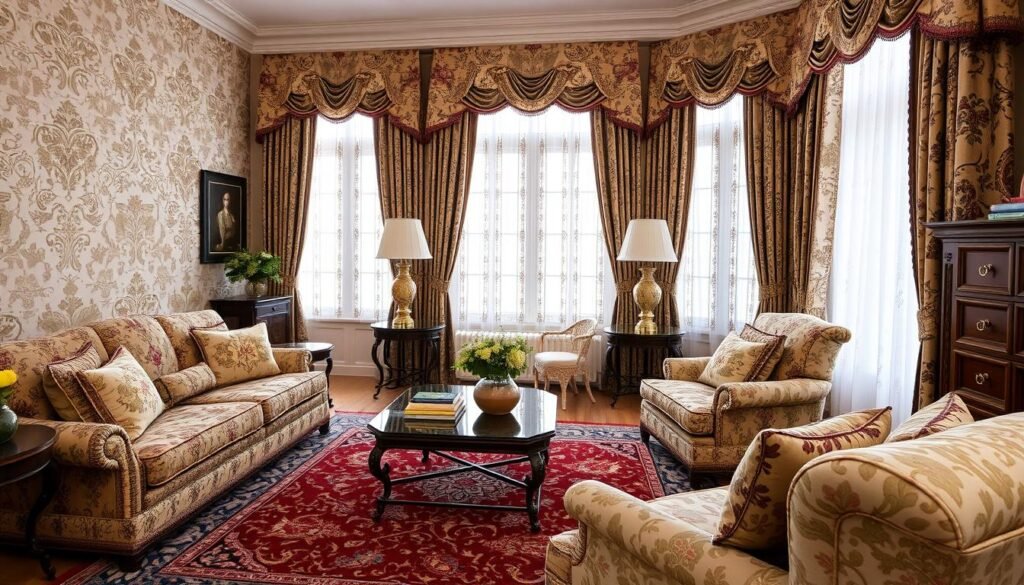
“Pattern mixing is described as more complicated than it seems, requiring a shrewd eye and fundamental knowledge of design and color theory.”
Modern Approaches to Pattern Mixing
Mixing patterns can seem scary, but with the right tips, you can make a stunning space. Today, people are bold and mix patterns in new ways. They’re moving away from matching everything and embracing bold, eclectic styles.
Understanding pattern analysis is key to modern mixing. It helps you pair patterns in a fresh way. Information extraction from design trends can also spark new ideas. It lets you add global and geometric patterns to your space.
Look to top designers for inspiration. They use natural language processing to mix patterns in amazing ways. Try layering floral prints with linear designs or mixing mid-century graphics with damask. The goal is to balance patterns for a stunning look.
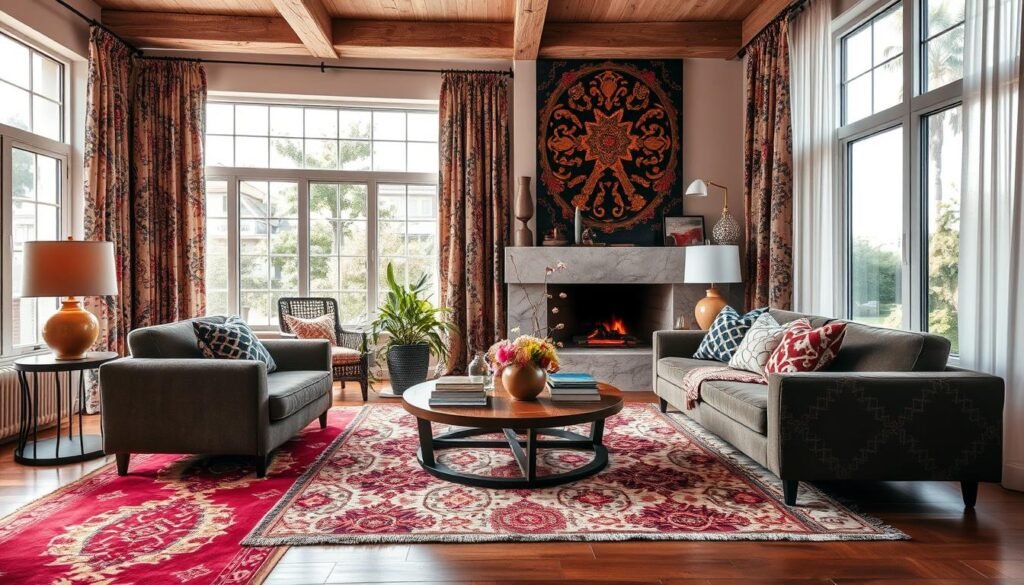
The secret to great pattern mixing is being creative and trusting yourself. With pattern analysis and design inspiration, you can make your spaces unique and eye-catching. Your living areas will become showcases of your style.
Balancing Pattern Intensity in Different Textiles
Creating a beautiful interior means knowing how to mix patterns in textiles. This includes rugs, cushions, and drapes. Getting the pattern balance right can transform your space.
Pattern Distribution in Large Spaces
In big rooms, finding the right pattern mix is crucial. Use at least three patterns, with bold prints making up 60% and smaller designs 20%. Add 10-15% neutrals for balance. This way, your space looks interesting yet unified.
Creating Focal Points
Patterns can make a room pop by creating focal points. A bold rug or furniture piece grabs attention. Then, use softer patterns and textures to balance it out. Odd numbers, like three, are great for mixing colors or patterns.
Texture is also key for balance. Mix velvets, jute, and silks to enhance patterns. Different textures add depth and coziness to your space.
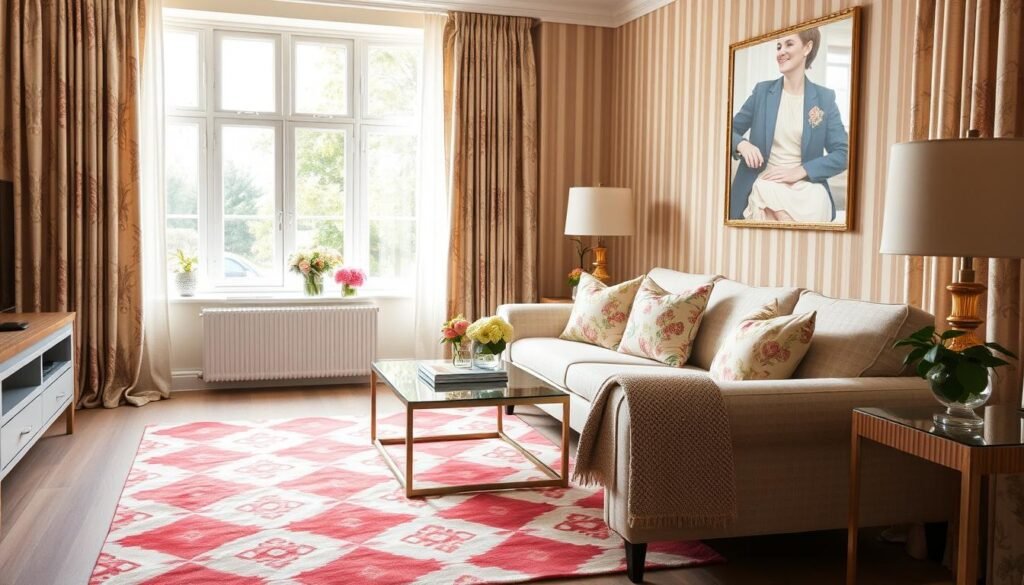
“Textures evoke successful interiors, quality fabrics play a crucial role, and textures can add interest and depth to a room.”
Mastering pattern intensity is all about experimenting and trusting your taste. Start with a patterned cushion and build up. Soon, you’ll create stunning, pattern-filled spaces that show off your style.
Common Pattern Mixing Mistakes to Avoid
Pattern mixing can turn a simple room into a lively and eye-catching space. But, it’s key to steer clear of common errors to get a design that works well together. Experts like Lark Interiors and Kelly Wearstler show how mixing textures in a single color scheme can make a room pop.
One big mistake is using too many patterns at once. Stick to three or fewer patterns and add solid colors or textures to keep things balanced. Knowing about color theory is also vital. Using patterns that are opposite each other on the color wheel can create a calm and harmonious look.
Using patterns that contrast, like bold shapes with soft flowers, can make a room feel lively. But, it’s important to keep the size and intensity of patterns in check. Mixing different types of patterns can add interest, but start small to build your confidence and skills.
| Pattern Mixing Tip | Explanation |
|---|---|
| Avoid Oversaturation | Limit patterns to three or fewer, and incorporate solid colors or textured fabrics for balance. |
| Understand Color Theory | Use complementary colors for a harmonious balance, or contrasting colors for an energetic ambiance. |
| Balance Pattern Scale and Intensity | Maintain a balance between pattern scale and color intensity to avoid overwhelming the observer. |
| Start Small and Build Confidence | Begin with carefully chosen fabrics when mixing patterns, and gradually experiment to find your unique style. |
Trying out different pattern combinations can help you find a style that feels like you. Avoiding common mistakes like using too many patterns or not understanding color theory can lead to a space that looks great and feels like home. This approach can also make your outfits more interesting and functional.
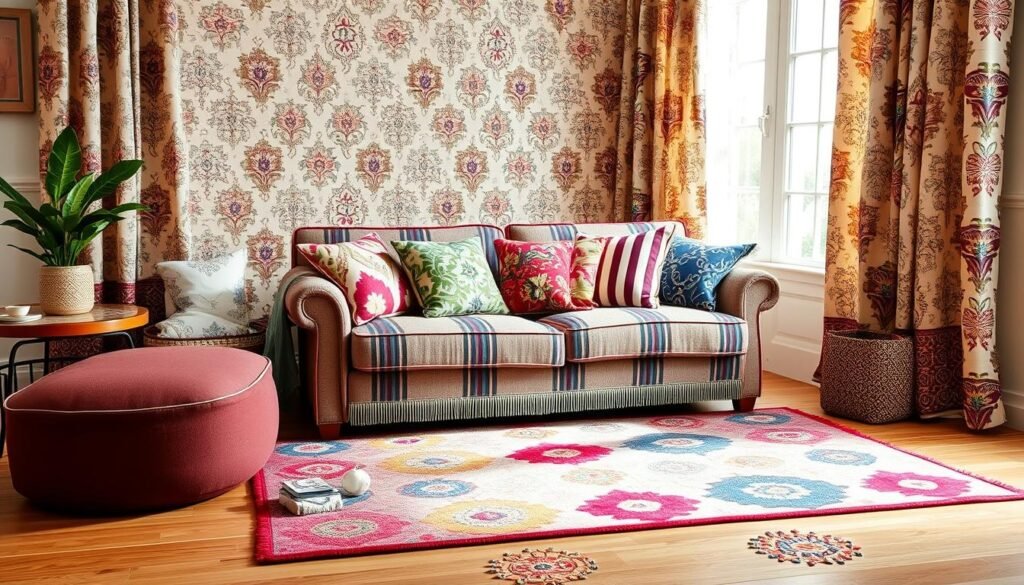
“If you’re new to pattern mixing, I recommend choosing your favorite patterned top and picking a printed accessory—like a purse, pair of shoes, or pair of sunglasses—to wear with it.”
The secret to great pattern mixing is knowing about sequence labeling, sequence learning, and feature extraction. By following these tips and being open to trying new things, you can make your living spaces truly special.
Pattern Layering Techniques for Different Room Styles
Creating a beautiful interior is like art. Mastering pattern layering is crucial. It makes any room look better, whether it’s traditional, modern, eclectic, or minimalist. By using clustering algorithms, sequence alignment, and frequent itemset mining, we can add depth and unity to any space.
In traditional rooms, classic patterns like florals and stripes work well. Mix different sizes and colors to create a balanced look. For example, pair a big floral with a small stripe. Eclectic rooms are all about bold patterns. Try mixing animal prints, geometric designs, and ikat for a unique look. Minimalist rooms need a gentle touch. Use patterns like linen or velvet to add texture and interest.
- Begin with a bold piece, like a patterned rug or furniture, and build the room around it.
- Use patterns of different sizes to make the space lively. Mix a big print with a small one.
- Add texture with various materials like wood, glass, and different fabrics.
- Choose a color scheme that ties everything together. Use colors that complement or contrast each other.
- Feel free to mix different patterns, like florals and stripes, for a bold look.
Learning pattern layering can turn any room into a stunning space that shows off your style. Use clustering algorithms, sequence alignment, and frequent itemset mining to make spaces that inspire and amaze.
| Design Style | Pattern Layering Techniques |
|---|---|
| Traditional | Classic floral, stripe, and damask patterns; coordinated color palette |
| Modern | Geometric designs, abstract motifs, and subtle textural patterns |
| Eclectic | Bold mix of patterns, including animal prints, ikat, and unexpected combinations |
| Minimalist | Layered textured patterns, such as linen and velvet, to add depth |
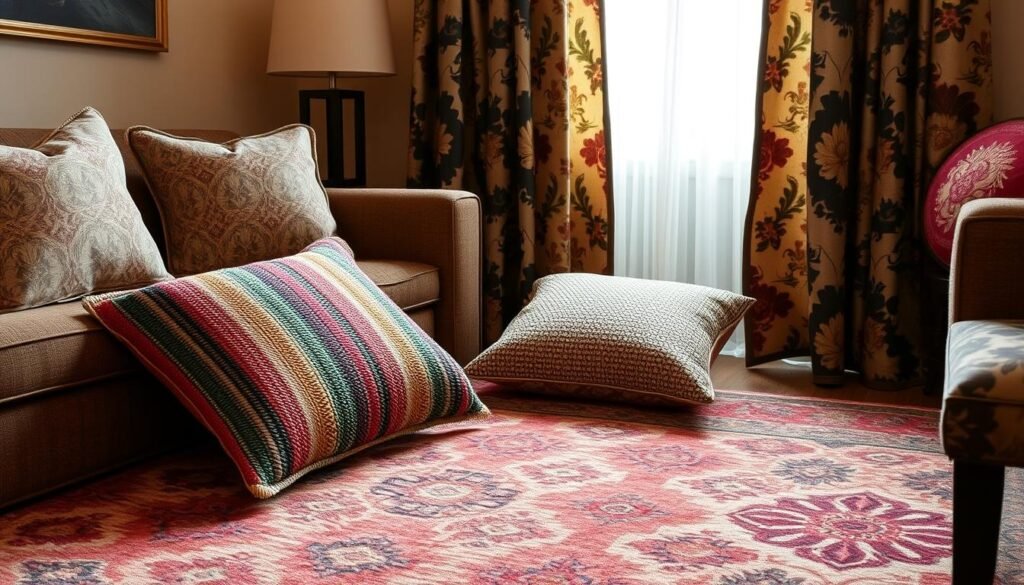
“Embrace the power of pattern layering to create visually stunning spaces that inspire and delight.”
Seasonal Pattern Combinations and Transitions
As seasons change, so should our home decor patterns. Adapting our patterns for each season keeps our spaces fresh and inviting. Let’s see how to smoothly switch from summer to winter and back!
Summer and Spring Patterns
Warm weather calls for light, airy patterns. Associative pattern discovery helps find unique pairings, like florals with geometrics or stripes with dots. Co-occurrence analysis makes choosing patterns easy. And motif detection finds patterns with shared design elements for a unified look.
- Crisp, white backgrounds with vibrant colors
- Breezy linen and cotton fabrics
- Whimsical floral and botanical prints
- Refreshing gingham and seersucker patterns
Fall and Winter Pattern Options
With cooler weather, it’s time for richer patterns. Velvety textures, deeper colors, and warm patterns bring coziness. Associative pattern discovery and co-occurrence analysis help find harmonious pairings for a cozy home.
- Luxurious velvets and corduroys
- Moody floral and paisley prints
- Plaid and tartan for a classic look
- Chunky knits and textural fabrics
Changing your patterns with the seasons creates a cohesive home. With creativity and motif detection, your spaces will be fresh, cozy, and in tune with nature.
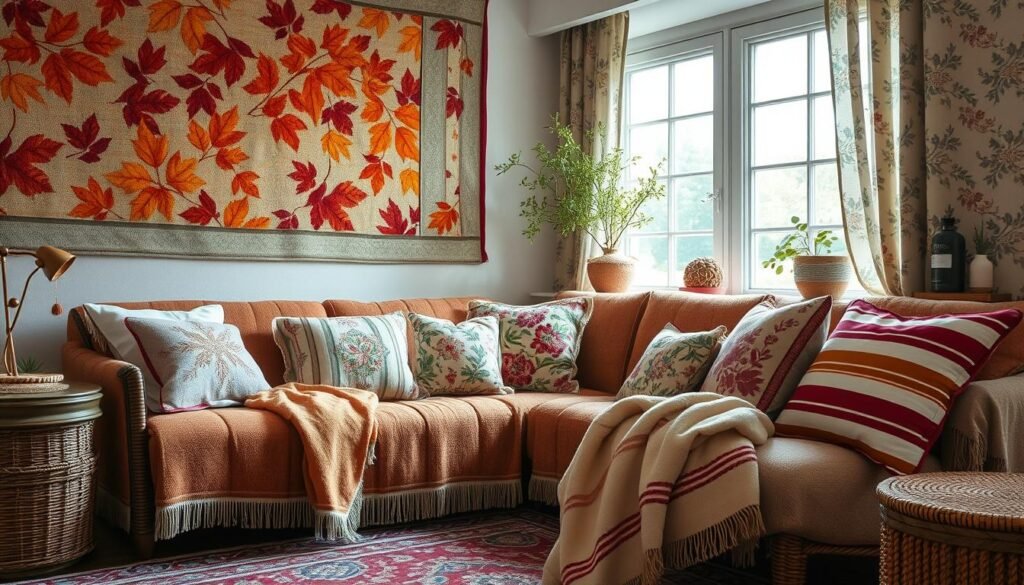
Pattern Mixing for Small Spaces
In home design, every inch matters. Pattern mixing is key for making small spaces look bigger. It adds visual interest and makes areas feel more open. By balancing scale, color, and texture, you can mix patterns without overwhelming the room.
Choosing the right scale is crucial for pattern mixing in small spaces. Mix small, medium, and large patterns for depth and dimension. Try bold geometric designs with delicate floral accents or use subtle stripes to balance big motifs. The rule of three – a small, medium, and large pattern – can make a space visually appealing.
Color coordination is also important in small spaces. Use a cohesive color palette with neutral tones and pops of vibrant colors. This balance lets the eye move smoothly through the space. By using associative pattern analysis, you can find patterns and textures that work well together.
ALSO READ:Easy Tips for Decorating with Bold Patterns
Frequently Asked Questions
What are the basic pattern types in home textiles?
Home textiles include florals, stripes, and geometrics. Knowing these patterns is key to mixing them well in your decor.
How does scale affect pattern selection?
Pattern scale is very important. Mixing big patterns with smaller ones adds interest and balance to a room.
What is the role of color theory in pattern coordination?
Color theory helps create harmonious colors for patterns. Using neutrals and bold colors can make your decor look cohesive.
What are the key guidelines for successfully combining patterns?
Follow the rule of three and balance patterns. Avoiding too much clutter is also important for mixing patterns well.
How can I incorporate traditional pattern mixing techniques?
Try mixing florals with stripes or elegant damask. Toile patterns can also add a timeless touch to your home.
What are some contemporary approaches to pattern mixing?
Try bold, eclectic mixes or combine geometric with organic patterns. Global-inspired patterns can also add a modern twist.
How can I balance pattern intensity across different textiles?
Spread patterns in large spaces and use bold ones as focal points. Texture can also help balance your patterns.
What are some common pitfalls in pattern mixing to avoid?
Avoid too many patterns, keep a consistent color palette, and don’t mix different styles too much.
How can I adapt my pattern combinations for different seasons?
Use light patterns for spring and summer. For fall and winter, choose richer, cozier patterns to keep your decor cohesive.
How can I incorporate patterns in small spaces effectively?
Use patterns to make small spaces look bigger. Choose the right scale and balance bold with subtle designs.

